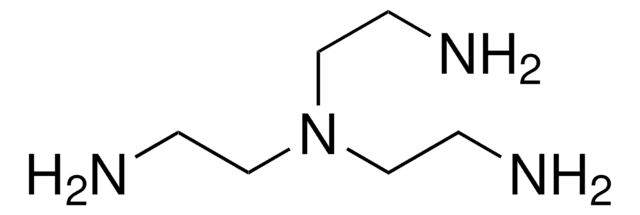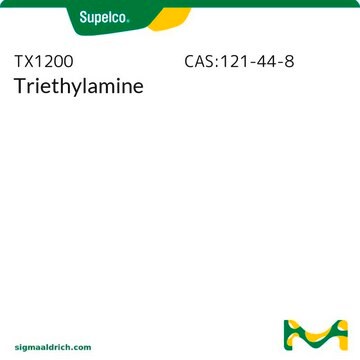T0886
Triethylamine
≥99%
Synonym(s):
TEA, N,N-Diethylethanamine
Select a Size
Select a Size
About This Item
Recommended Products
vapor density
3.5 (vs air)
Quality Level
vapor pressure
51.75 mmHg ( 20 °C)
Assay
≥99%
autoignition temp.
593 °F
shelf life
3 yr
expl. lim.
8 %
impurities
≤0.5% water (Karl Fischer)
refractive index
n20/D 1.401 (lit.)
bp
88.8 °C (lit.)
Looking for similar products? Visit Product Comparison Guide
1 of 4
This Item | 90340 | 900632 | 90337 |
|---|---|---|---|
| assay ≥99% | assay ≥99.5% (GC) | assay ≥99% | assay ≥99.5% (GC) |
| refractive index n20/D 1.401 (lit.) | refractive index n20/D 1.401 (lit.) | refractive index n20/D 1.401 (lit.) | refractive index n20/D 1.401 (lit.) |
| mp −115 °C (lit.) | mp −115 °C (lit.) | mp −115 °C (lit.) | mp −115 °C (lit.) |
| expl. lim. 8 % | expl. lim. 8 % | expl. lim. 8 % | expl. lim. 8 % |
| vapor pressure 51.75 mmHg ( 20 °C) | vapor pressure 51.75 mmHg ( 20 °C) | vapor pressure 51.75 mmHg ( 20 °C) | vapor pressure 51.75 mmHg ( 20 °C) |
Application
also commonly purchased with this product
suggested gloves for splash protection
Signal Word
Danger
Hazard Statements
Precautionary Statements
Hazard Classifications
Acute Tox. 3 Dermal - Acute Tox. 3 Inhalation - Acute Tox. 4 Oral - Eye Dam. 1 - Flam. Liq. 2 - Skin Corr. 1A - STOT SE 3
Target Organs
Respiratory system
Storage Class Code
3 - Flammable liquids
WGK
WGK 1
Flash Point(F)
12.2 °F - closed cup
Flash Point(C)
-11 °C - closed cup
Personal Protective Equipment
Choose from one of the most recent versions:
Already Own This Product?
Find documentation for the products that you have recently purchased in the Document Library.
Customers Also Viewed
Articles
Amide bonds are ubiquitous in both nature and industrial applications. They are vital to the structure and function of biological macromolecules and polymers. The importance of this functionality has resulted in numerous approaches to its formation, ranging from stoichiometric activation of carboxylic acids to more recent advances in catalytic amide bond formation.
The Heck reaction is the palladium catalyzed cross-coupling reaction between alkenes and aryl or vinyl halides (or triflates) to afford substituted alkenes.
Our team of scientists has experience in all areas of research including Life Science, Material Science, Chemical Synthesis, Chromatography, Analytical and many others.
Contact Technical Service












